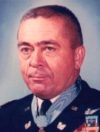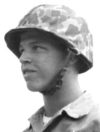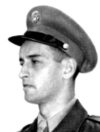Today in Medal of Honor history
 On Oct. 2, 1969, Chief Warrant Officer Michael J. Novosel gets the call that a team of South Vietnamese are pinned down in Vietnam’s Kien Tuong Province, and the medevac pilot heads to the rescue. As he circles overhead to rally the beleaguered troops while they prepared to be lifted out, enemy fire is so intense that his helicopter is driven away six times. Undeterred, Novosel – who would be wounded by close-range automatic weapons fire during the daring mission – performed 15 extractions under fire, saving 29 soldiers.
On Oct. 2, 1969, Chief Warrant Officer Michael J. Novosel gets the call that a team of South Vietnamese are pinned down in Vietnam’s Kien Tuong Province, and the medevac pilot heads to the rescue. As he circles overhead to rally the beleaguered troops while they prepared to be lifted out, enemy fire is so intense that his helicopter is driven away six times. Undeterred, Novosel – who would be wounded by close-range automatic weapons fire during the daring mission – performed 15 extractions under fire, saving 29 soldiers.
This was Novosel’s second tour flying medevac helicopters in Vietnam. The “Dean of the Dust-Offers” flew an amazing 2,543 missions, rescuing 5,589 personnel. He had flown B-29s during World War II, and also served during Korea. By the time Novosel retired in 1985, he was the last World War II aviator still on active duty. His son also flew medevac choppers, and both father and son would take turns rescuing each other during the Vietnam War.
Novosel’s full Medal of Honor citation can be read here
 On Oct. 2, 1952, Private First Class Jack W. Kelso’s platoon is hit by a heavy enemy assault that takes both the platoon commander and platoon sergeant out of action. Kelso exposes himself to enemy small arms and mortar fire, attempting to rally his fellow Marines. Met by a hail of fire, he seeks cover in a bunker, which is quickly targeted by an enemy grenade. Kelso picks up the grenade and moves to an exposed position to throw it back at the enemy when it goes off after leaving his hand – peppering Kelso with shrapnel. Instead of remaining in the bunker, the mortally wounded Kelso opts to expose himself to the withering fire and provide cover fire while his men move to another position.
On Oct. 2, 1952, Private First Class Jack W. Kelso’s platoon is hit by a heavy enemy assault that takes both the platoon commander and platoon sergeant out of action. Kelso exposes himself to enemy small arms and mortar fire, attempting to rally his fellow Marines. Met by a hail of fire, he seeks cover in a bunker, which is quickly targeted by an enemy grenade. Kelso picks up the grenade and moves to an exposed position to throw it back at the enemy when it goes off after leaving his hand – peppering Kelso with shrapnel. Instead of remaining in the bunker, the mortally wounded Kelso opts to expose himself to the withering fire and provide cover fire while his men move to another position.
Kelso’s full Medal of Honor citation can be read here
 On this date 73 years ago, as the 85th Infantry Division fights their way across Italy, Sgt. Christos H. Karaberis’ platoon was pinned down by enemy fire. Karaberis – who changed his name to Chris Carr following the war – crept to the rear of an enemy machine gun position. Leaping forward and shooting his submachine gun into the position, he caught the occupants by surprise – capturing eight enemy soldiers. Carr moved on to the next position – this time maneuvering to avoid enemy fire – killing four soldiers and capturing another. Carr then moved against a third machine gun position, forcing the enemy troops to surrender. Incredibly, Carr would charge two more positions, bringing his total to five machine gun nests, killing eight enemy soldiers, and capturing 22.
On this date 73 years ago, as the 85th Infantry Division fights their way across Italy, Sgt. Christos H. Karaberis’ platoon was pinned down by enemy fire. Karaberis – who changed his name to Chris Carr following the war – crept to the rear of an enemy machine gun position. Leaping forward and shooting his submachine gun into the position, he caught the occupants by surprise – capturing eight enemy soldiers. Carr moved on to the next position – this time maneuvering to avoid enemy fire – killing four soldiers and capturing another. Carr then moved against a third machine gun position, forcing the enemy troops to surrender. Incredibly, Carr would charge two more positions, bringing his total to five machine gun nests, killing eight enemy soldiers, and capturing 22.
Chris, I am so amazed on how much info is online on me father Christos Karaberis WWII hero. If you have anything new on him esp photos I would appreciate seeing. Thank you